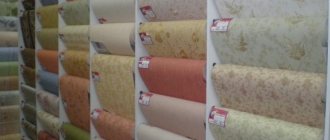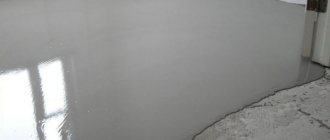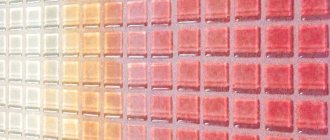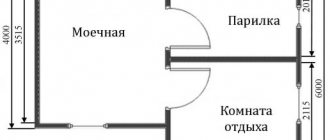What determines the number of wallpapers?
From the size of the room (more on this below) and from the design. One roll is usually 10 meters. If the wallpaper is plain and the ceiling height is 2.5 meters, you can cut the roll into four strips. If the drawing has to be adjusted, there will be three stripes.
Free docking
stroyday.ru
There is no matching of patterns: the roll is simply cut into the required number of panels. Usually these are plain wallpapers, wallpapers with abstract patterns or vertical stripes.
Direct docking
stroyday.ru
The drawing will have to be combined horizontally so that adjacent stripes begin with the same elements. And here everything will depend on the height of the repeat - the distance through which the pattern is repeated (indicated on the label). In the worst case, you will have to throw away almost the entire height of the repeat, so when calculating it must be added to the height of the ceiling.
Offset docking
stroyday.ru
The drawing is located diagonally, so each canvas moves. As a rule, half rapport. In this case, you need to add the repeat height and the offset value to the ceiling height: you will find both numbers on the label.
Why keep a roll for spare?
A spare roll of wallpaper for the room can save the situation if the initial calculations turn out to be incorrect. Pet owners or new parents will also appreciate their foresight in the event of damage to the coating.
Should windows and doors be “subtracted”?
When calculating the total area, door and window openings must be taken into account. As practice shows, in places above a door or window, the remaining small pieces will be used, but there is simply no need for the whole canvas.
Should I wallpaper behind furniture?
Reasonable savings never hurt, therefore, it is necessary to clarify two details.
- First: is there a reshuffle planned in the future? If the possibility cannot be excluded, it is better to play it safe than to start repairs again in a couple of years. An exception is gluing the walls behind the kitchen unit, built-in wardrobe and other permanently located furniture.
- The second important point: is the savings justified? Sometimes it’s easier to cover the entire room at once. And saving one or two rolls is unlikely to have a significant impact on the overall cost of repair work.
Free docking
Used for products with small and asymmetrical patterns. The canvases can be glued in any order; there is no need to match the pattern or maintain the direction of the canvas. This type can be easily calculated by the area of the walls, leaving one roll in reserve for unaccounted pieces for gluing over windows and doorways.
Direct docking
Canvases of this type do not need to be shifted to align the pattern; the pattern is symmetrical. Calculating the quantity is quite simple by determining the total area of the room.
How to calculate the amount of wallpaper using tables
This is an ideal method if the room is square or rectangular and the wallpaper does not require adjustment. All you need is the area of the room and the height of the ceiling.
Calculation of the number of narrow wallpapers (width – 53 cm, length – 10 meters).
remont-otdelka-m.ru
Calculation of the amount of wide wallpaper (width - 106 cm, length - 10 meters).
remont-otdelka-m.ru
Conclusion
With 100% accuracy, down to several centimeters or grams, no specialist will be able to calculate the required amount of material. Therefore, no matter how hard you try, the data will be averaged, because for the same room, different types of wallpaper are used differently. The only question is how approximate they will be.
The video in this article shows the technology of wallpapering a room.
How to calculate the number of wallpapers mathematically
If the room has a complex shape, there are bends and niches, it is better to count along the perimeter. To do this, you need to add up the lengths of all the walls. Window and door openings less than 60 cm wide are considered a flat wall; wider ones are excluded from the calculation. The resulting value is rounded up.
Example: 2.75 m + 3 m + 0.4 m + 2.85 m + 4 m + 0.65 m = 13.65 m ≈ 14 m.
Then you need to determine the number of strips: divide the perimeter by the width of the roll. Let's return to our example: 14 m / 1.06 m = 13.2. Rounding up - 14 wide wallpaper sheets. For narrow wallpaper: 14 m / 0.53 m = 26.4. That is 27 stripes.
Now you need to determine how many strips can be obtained from one roll: the length of the roll must be divided by the length of the strip. And there can be three options:
- If the wallpaper does not require adjustment, the length of the strip is equal to the height of the ceiling. 10 m / 2.75 = 3.6 ≈ 3.
- If the wallpaper is directly joined, the length of the strip is equal to the sum of the ceiling height and the repeat height (0.6 m). 10 m / (2.75 + 0.6) = 2.9 ≈ 2.
- If the wallpaper is jointed, the length of the strip is equal to the sum of the ceiling height, repeat height (0.6 m) and offset value (0.3 m). 10 m / (2.75 + 0.6 + 0.3) = 2.7 ≈ 2.
The last step: divide the number of strips we need by the number of strips in the roll. If the wallpaper is wide, 14 will need to be divided by 3 or 2. If it is narrow, divided by 3 or 2 will need to be 27 stripes.
How to calculate wallpaper for a room: options, formulas, features
To know how to calculate the required amount of wallpaper, you will need to use one of the methods:
- along the perimeter of the walls and the number of strips cut;
- by the area of the walls and all surfaces to be pasted;
- using online applications and wallpaper calculator services.
One way to calculate the amount of wallpaper is to measure the perimeter of the walls and the number of strips to be cut
Each of these methods has its own calculation errors, but using them is much more effective than buying wallpaper without any clarification at all. From available materials, you will need to prepare a tape measure for measurements, paper and pen for notes, and a calculator. Calculating the amount of wallpaper per room is simple; you don’t need outstanding mathematical skills, the main thing is to understand the principle and follow it.
Important! All measurements should be taken only with a tape measure. Approximate data and large tolerances will not lead to accurate calculations.
How to calculate the amount of wallpaper per room along its perimeter
The perimeter is the sum of the lengths of all sides of the polygon. In this case, the polygon is the room in which the renovation will be carried out. Take a tape measure and measure the lengths of all walls from corner to corner, excluding the baseboard and frieze. If the room has a bay window, each of its walls must also be measured. Don't be lazy to take measurements of all the walls, because... It may turn out that surfaces that are visually parallel are in reality not exactly the same in length.
To calculate the perimeter you need to measure all the walls of the room
Now you can calculate the perimeter of the room as the sum of all measured sides:
- P total = length 1 + length 2 + …+ length N,
where N is the number of walls in the room.
The next step is to measure the height of the room from floor to ceiling. To do this, you again need to use a tape measure.
Helpful advice! Ceiling heights can vary within one room by several centimeters. Therefore, you should take several measurements and select the largest value.
When the height of the walls is known, you can find out the length of one piece of wallpaper. In this case, you will need the marking data for the rolls selected earlier in the store:
- canvas length = room height + repeat height + offset amount + 5 cm allowances for top and bottom bleed
Now again you need to refer to the markings to find out the length of each roll, because the next step will be to calculate the number of blade cuts in one roll:
- number of cuts per roll = length of 1st roll / length of 1st blade
When gluing wallpaper with a pattern, you need to adjust the stripes to match the pattern
Using the known width of the roll, you can calculate how many cuts are needed to cover the entire room:
- number of cuts per room = room perimeter / roll width
And finally, the main calculation is how to calculate the number of rolls of wallpaper per room:
- number of rolls = number of cuts per room / number of cuts per roll
When trying to calculate the number of rolls of wallpaper, the calculator will not show an integer value. It should be rounded up, since rolls are not sold in parts.
If, when calculating rolls of wallpaper, the result is a non-integer number, then it must be rounded up
The complete algorithm for calculating the number of rolls of wallpaper around the perimeter of a room will look like this:
- Take measurements of the lengths of all walls.
- Take measurements of the height of the room.
- Calculate the perimeter of the room using the formula.
- Find out the length of one sheet for pasting.
- Calculate the number of cuts in a roll.
- Calculate the total number of cuts for all walls.
- Find out the required number of selected wallpaper rolls.
Important! When calculating sheets for one roll, you should round the resulting value down to know the number of whole cuts. When calculating the final number of cuts for the entire room, you need to round up, on the contrary, so that you are guaranteed to have enough wallpaper to paste.
How to calculate the amount of wallpaper based on the area of the surfaces to be pasted
Taking the perimeter into account when determining the amount of wallpaper to renovate is not a completely accurate method because it does not take into account the presence of wall openings for doors and windows. To clarify the data, it is worth calculating the area of the walls; the calculator can handle this easily, but there are more measurements to be taken in the room. You will need data on the dimensions of the walls, all existing openings, protrusions, niches, taking into account the features of the topography and layout of the room.
When calculating the area of the room, you will need to measure all openings and niches
Initially, calculate using a wall area calculator - each separately, using the formula:
- wall area = wall length x wall height
If the selected wallpaper has a repeating pattern and offset, then you need to add the repeat height and offset to the height of the wall. Their values are indicated on the roll packaging.
Then the results obtained are summarized. Next, in a similar way, calculate the areas of all openings and also find their sum. Then the calculator calculates the area of the walls that will be used for wallpapering:
- wallpapering area = total wall area – total area of openings
This data is not yet sufficient to determine the number of rolls. To find out the final value, you need to first calculate the area that 1 roll of wallpaper can cover:
- area of 1st roll = width of 1st roll x length of 1st roll
Using wallpaper markings you can find out the width and length of the roll
The width of the roll and its length are taken from the marking of the selected wallpaper in the room; it is already specified by the manufacturer and is on the label attached to each material.
Now the last step is to calculate the total number of rolls needed for the repair:
- number of rolls = wallpapering area / area of 1 roll
Most likely, when calculating rolls of wallpaper by area of the room, the calculator will not show an integer number. For the final result it needs to be rounded up.
The complete area calculation algorithm can be formulated as follows:
- Take measurements of the dimensions of all walls and openings in the room.
- Calculate the area of each wall using the formula and sum the resulting values.
- Find out the total area of the openings by summing the pre-calculated areas of each of them.
- Calculate the difference between the total area of the walls and the total area of the openings. This will be the surface for wallpapering.
- Find out the area of one selected roll of wallpaper.
- Calculate using the formula for determining the number of rolls required for repairs.
Graphic method: calculate wallpaper for a room using visualization
Correctly calculating the amount of wallpaper, as the described methods show, is quite simple. However, for clarity, you can present the calculations graphically, in which case they will be easier to perceive visually. Additionally, it will become clear where to start gluing, where trimming, corner formation, etc. will take place.
When gluing wallpaper, taking into account the adjustment of the pattern, you will need an additional roll to decorate the walls above the openings
For the graphical method you need:
- Draw an expanded sketch of the room, taking into account the dimensions of the walls and all openings.
- Indicate on the diagram all known height and width data.
- Apply a grid arrangement of wallpaper sheets, knowing their width.
- Count the number of resulting cuts.
- Calculate the length of the web and the number of cuts in the roll, as was done in the perimeter calculation method.
- Calculate the number of wallpaper rolls per room, rounding up to the nearest whole number.
Related article:
Wallpaper in Provence style for an elegant and luxurious design
How to choose the right wallpaper in Provence style. Selection criteria for decorating a bedroom, kitchen, living room and children's room.
On the other hand, if the width of the new wallpaper coincides with the width of the old ones that cover the room, you can calculate the number of required canvases directly on the walls.
How to calculate wallpaper using online services
The Internet helps in solving many issues, so if you don’t want to count manually, you can calculate the number of wallpapers online. Various types of counting programs are published on specialized websites. It is recommended to select those where you need to indicate the largest number of room parameters and characteristics of the selected material.
For more convenient measurement of walls, you can use a laser level
The online calculator calculates wallpaper based on the data that is loaded into it for processing. You will definitely need wall parameters: length and height. If a high-quality calculator is selected, then it will have columns for filling in the dimensions of door and window openings, as well as taking into account the displacement of the pattern.
Important! Please note the units of measurement for all fields in the online calculator form. It is permissible to calculate wallpaper for a room in meters or centimeters. Only the same units of measurement are used for one shape.
All that is required to get the result is to fill out all the fields correctly and press the count button. The program will perform the calculation instantly. Using an online calculator, you can calculate the wallpaper directly in the store, making it easier to navigate the price range of your choice.
A way to calculate wallpaper for walls adjusted for design decisions
Inspired by design solutions, you can wallpaper one room with a combination of several types of wallpaper. It will be bold and extraordinary if you choose the right combination. In this case, you can calculate the amount of wallpaper using any of the above methods, you just need to take into account each type of material separately.
To count wallpaper for pasting a room, taking into account the design solution, you can use any method for calculating the number of required rolls
For example, an insert can occupy the entire area of one of the walls. Then the number of main wallpapers for 3 walls is determined, plus you will separately find out how many rolls will be needed to paste the insert. Difficulty may arise if the selected combination of materials has different roll widths, so pay close attention to the markings. You should take measurements especially carefully if you are using a 3D print or photo wallpaper for insertion.
Another option: the decor does not occupy the entire wall, but only part of it, and there is a space filled with the main wallpaper on top, on the sides and, possibly, below (panel organization). In this case, the decorated insert is taken as an additional wall opening. You can calculate the wallpaper for a room using a calculator online or manually. The material consumption for decor is calculated separately in any way.
If you thought about covering a wall with the organization of panels and edging with a border, then separately calculations are made for the wallpaper on the top and bottom (panels) in a convenient way, taking into account the characteristics of the selected material.
Down with the calculator: how to calculate wallpaper for a room using tables
If it is difficult to calculate using simple but numerous formulas and a calculator, wallpaper for walls can be calculated in another way. For this purpose, reference auxiliary tables are used, compiled taking into account the width and length of the rolls, as well as the geometric dimensions of the premises. The values indicated in them can serve both as a guide for purchasing material for repairs, and as a check of independently performed mathematical calculations for the perimeter and area of the walls.
Using the table you can find out the number of rolls when calculating wallpaper around the perimeter of the room for rolls 0.52 m wide and 10.05 m long
The tables were compiled without taking into account the repeat of the pattern or its displacement, so the desired values need to be adjusted according to the height of the ceilings, adding additional data on the features of the pattern to the measured values of the room. Thus, the measured ceiling height will be greater by the repeat height plus the offset height. To be scrupulously accurate, it is worth adding another 5 cm allowance for the curvature of the walls for the bottom and top. Based on the final value, you should be guided in choosing the number of rolls according to the table.
Important! In the tables, the floor area is taken as the calculated area, and not the total area of the walls, as in mathematical calculations.
The table shows the number of rolls in accordance with the ceiling height and the perimeter of all walls
An example of a mathematical calculation of the required amount of wallpaper for a room
To make it clear how the calculation methods described in the article work, let’s calculate the amount of material using a specific example.
Let's say you need to wallpaper a room with one window and a door. Initially we take measurements indoors. For the selected example room we get:
- room length – 7.5 m;
- room width – 3 m;
- ceiling height – 2.6 m;
- window dimensions – 2.1x1.5 m;
- door dimensions – 0.9x2.0 m.
Let's assume that wallpaper with a large pattern was previously selected for pasting: repeat height - 0.35 m and offset - 0.25 m. Roll dimensions: width - 0.53 m, length - 10.05 m. Also take into account that on There are uneven walls in the room, so let’s add allowances of 0.05 m to them.
Data for verifying the results of calculating the number of rolls by room area
Note! All values for calculation are given in the same units of measurement.
Using the perimeter calculation method, we find out how many rolls of the selected material will be needed to cover a room with the given parameters:
- Room perimeter: (7.5 + 3) x 2 = 21 (m).
- Height of the canvas taking into account repeat, offset and allowances: 2.6 + 0.35 + 0.25 + 0.05 + 0.05 = 3.3 (m).
- Number of cuts per roll: 10.05: 3.3 = 3.05 (pcs.). We round down, we get 3 full-length canvases from 1 roll and the remainder 0.15 m long, i.e. Almost the entire roll will be used.
- The total number of cuts needed per room is: 21: 0.53 = 39.62 (m). We round the obtained data up, we get 40 segments.
- We calculate how many total rolls are needed for the room: 40: 3 = 13.33 (rolls). We round the data up for a small margin: 14 rolls are needed.
When calculating wallpaper along the perimeter, the area of windows and doors is not taken into account
Let's check the values using another calculation method - by the area of the room:
- Total wall area: (7.5 x (2.6 + 0.35 + 0.25 + 0.05 + 0.05) + 3 x (2.6 + 0.35 + 0.25 + 0.05 + 0.05)) x 2 = 69.3 (m²). Don’t forget that we have chosen wallpaper with a pattern, so we add the rapport height and offset to the ceiling height and additionally take into account allowances for wall unevenness.
- Window opening area: 2.1 x 1.5 = 3.15 (m²).
- Doorway area: 0.9 x 2 = 1.8 (m²).
- Total area of openings: 3.15 + 1.8 = 4.95 (m²).
- Let's find out the required area for pasting (the difference between the total area of the walls and the total area of the openings): 69.3 - 4.95 = 64.35 (m²).
- Find the area of the wallpaper roll: 0.53 x 10.05 = 5.33 (m²).
- We calculate the total number of rolls for pasting: 64.35: 5.33 = 12.07 (rolls). We round up to a larger integer value and get the desired value - 13 rolls. You can take a risk and round the result down due to the small fractional part in the calculations, but it is recommended to always have a free supply of material when selecting a pattern.
To make sure your calculations for wallpaper rolls are correct, you can use an online calculator
If you compare the calculation data for the perimeter and area, you will find a discrepancy of 1 roll, because in the second case, the window and door openings, which are not covered with wallpaper, were taken into account. You can additionally check the calculations with an online calculator to finally verify their correctness, and also check them in the reference tables.
How to calculate the number of wallpapers using services and applications
The fastest way if you know the parameters of the room, and the simplest if you are not good with mathematics. There are many wallpaper calculators on the Internet, here are just a few good ones.
- Wallpaper calculator from calc.by. It calculates both by area and by perimeter, allowing you to exclude door and window openings from the calculation. You can also set the width and footage of the roll.
- Wallpaper calculator from calc.ru. Performs calculations along the perimeter. Helps determine how much wallpaper and glue is needed.
- Wallpaper calculator from remont-online.com. First, the configuration of the room is selected, then the width of the walls and wallpaper is set. You can also specify the price per roll to find out the total cost of the pasting.
If you are already in the store, use the application for calculations. Here are two free ones with good ratings.
Application not found
Construction calculator - calculation of materials
Will Maze
Price: Free
Download
Price: Free
How to choose the type of wallpaper
In addition to quantity, the selection of canvas from the appropriate material will also be important. You must understand that not all materials can be universal, so what you can stick with your own hands in the kitchen is unlikely to be a good option in a children's room.
Wallpaper calculation table and pictograms on them
Manufacturers today offer a wide range of wall coverings of this type, the prices of which differ from each other, including paper, non-woven, vinyl, fabric, bamboo, velor:
- When selecting wallpaper for wet rooms, for example, a bathroom, kitchen or corridor, it is better to give preference to washable coatings. In addition, they must be as resistant to mechanical stress as possible;
- to decorate walls in a bedroom, living room or children's room, it is better to buy natural coverings (bamboo or paper);
- Velor and fabric options are well suited for a decorative effect. However, they are very unprofitable in operation.
Is it possible to return excess wallpaper to the store?
Article 25 Article 25. The consumer’s right to exchange goods of proper quality under the “Law on the Protection of Consumer Rights” provides for the return of all purchased goods if they do not match the style or color. And subject to a number of conditions.
- Wallpaper was sold in rolls, not by the meter. The list of NON-FOOD PRODUCTS OF GOOD QUALITY, NOT SUBJECT TO RETURN OR EXCHANGE FOR A SIMILAR GOODS OF OTHER SIZE, SHAPE, SIZE, STYLE, COLOR OR EQUIPMENT of non-food products of proper quality, not subject to return or exchange, includes finishing materials. But we are talking only about goods sold by the meter.
- The wallpaper remained unopened, not wrinkled or scratched.
- No more than 14 days have passed since the date of purchase. When purchasing online – 7 days.
- There is a receipt or other document confirming the fact of purchase. If the receipt has not been saved, you can request a cash register tape (stores keep it for a month) or attract witnesses.
In other words, if you don't like the wallpaper, you can take it back to the store. All rolls. In this case, the seller will offer you a similar product, and if there is none, you can write a request for a refund.
Returning one or two extra rolls after repair will be problematic. But large stores usually accommodate customers halfway. After all, they purchase wallpaper in large quantities, and plus or minus one roll does not particularly affect sales. Customer loyalty is more valuable.
Just in case, check the return policy before purchasing.
Pro tips for counting wallpaper
To ensure that the result of the repair does not disappoint, when calculating wallpaper and when purchasing it, you should pay attention to some details:
- Always purchase rolls from the same batch. Material from different batches may vary slightly in color. The shades are not too noticeable on a roll, but on the wall a serious flaw will be revealed.
- Take a close look at the wallpaper you choose. Even a small pattern can have a repeat, which can significantly increase material consumption. If the calculation was made without taking into account allowances for combining the pattern, then there may not be enough wallpaper.
- You can save on footage by using leftovers from cuts of solid panels. They are glued above doorways, as well as above and below the window. In this case, it is necessary that the lateral joining be carried out according to the drawing.
- If the height of the repeat is large and there is a sufficiently large offset, it is worth buying an additional roll. If the area to be covered is large, buy 1 additional roll per 6 calculated rolls.
- When cutting the canvas, always add allowances for the curvature of the walls, 5 cm is enough for the top and bottom. Take this parameter into account when making calculations.
- For narrow door openings (less than 60 cm), their area is not calculated. In this case, they are not taken into account at all, and the assumption is made that there is a flat wall in their place.
- When paying for material in a store, ask about the possibility of returning wallpaper and be sure to keep your receipt. Returns are allowed within 14 days after purchase, if such a service is available in the store, the roll must be intact and unopened.
To save on wallpaper, you can use the pieces that are left from solid rolls for small areas of the walls
The methods outlined in the article on how to calculate how much wallpaper is needed for repairs are used, as a rule, when doing the work of wallpapering premises independently. Each of them has a small error, but they all cope with the main computational task.
Who needs a quote for wallpapering and why?
If we are talking about repairs by a professional, then there are two sides to the process - the customer and the contractor. The question is – which of them needs the price figure more?
Most homeowners are not aware of the current prices for either the complex of wallpapering work or the component operations. Therefore, when choosing a contractor, the customer, as a rule, is interested in the cost of the entire scope of work, which the applicant contractors tell him.
If the stated amount seems too high, turn to another professional. But, having chosen an acceptable contractor, you still need to calculate the price - for yourself. In the future, this will be useful in negotiations on identical repairs of other premises, because the amounts there will also be quoted differently - linked to the area. In addition, the customer’s decision whether to carry out the finishing using this method, or choose another, or even refuse repairs until better times, largely depends on the amount of costs, and it is determined, among other things, by prices.
As for contractors, experienced professionals have an average base figure from which they build when determining the cost of a specific order. At each site, the contractor makes adjustments to this starting price - up or down, depending on the specifics of the work. The contractor often has to defend his prices to the customer - break down the work into component operations, pay attention to the individual difficulties of execution, justify the measurement figures, etc. This skill comes with experience - again through calculating the cost of wallpapering, which every beginner in this profession faces.
Thus, the ability to calculate the cost of wallpapering is, to one degree or another, necessary for both the customer and the contractor.











